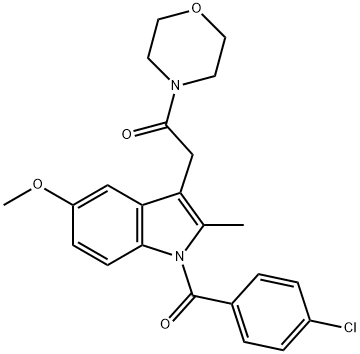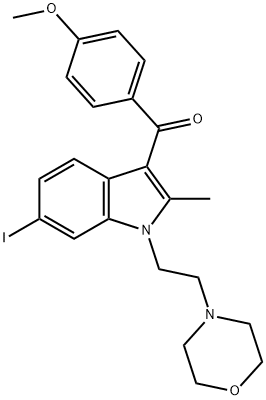ACPA
- CAS NO.:229021-64-1
- Empirical Formula: C23H37NO
- Molecular Weight: 343.55
- MDL number: MFCD02683582
- SAFETY DATA SHEET (SDS)
- Update Date: 2025-08-20 16:56:09

What is ACPA?
Description
Arachidonoyl cyclopropylamide (ACPA) is a potent and selective cannabinoid (CB) receptor 1 agonist with Ki values of 2.2 and 715 nM for CB1 and CB2 receptors, respectively. In whole animal experiments, ACPA induces hypothermia in mice with the same efficacy as arachidonoyl ethanolamide (AEA; ), in spite of its higher affinity for the CB1 receptor. These data have been interpreted to indicate that ACEA may be a substrate for fatty acid amide hydrolase (FAAH), and thus only transiently available in whole animal experiments.
The Uses of ACPA
A synthetic agonist of the cannabinoid receptor 1 (CB1R). ACPA is considered to be a selective cannabinoid agonist as it binds primarily to the CB1R and has low affinity to the cannabinoid receptor 2 (CB2R).
What are the applications of Application
Arachidonylcyclopropylamide (ACPA) is a cannabinoid CB1 receptor agonist
Biological Activity
Potent and selective CB 1 agonist (K i = 2.2 nM). Displays 325-fold selectivity over CB 2 receptors. Active in vivo . Also available in water soluble emulsion (N-(Cyclopropyl)-5Z,8Z,11Z,14Z-eicosatetraenamide ).
Enzyme inhibitor
This highly selective, synthetic CB1 receptor agonist (FW = 343.55 g/mol; CAS 229021-64-1), also known as arachidonylcyclopropylamide and N(cyclopropyl)-5Z,8Z,11Z,14Z-eicosatetraenamide, targets CB1 cannabinoid receptor agonist (Ki = 2.2 nM) with >325-fold selectivity over CB2 receptors. Two subtypes of the cannabinoid receptor (CB1 and CB2) are expressed in mammalian tissues. Although selective antagonists are available for each of the subtypes, most of the available cannabinoid agonists bind to both CB1 and CB2 with similar affinities. ACPA possesses the characteristics of CB1 receptor agonists, inhibiting forskolininduced cAMP accumulation in Chinese hamster ovary cells expressing the human CB1 receptor. It also increases the binding of [35S]GTPgS to cerebellar membranes and inhibits electrically evoked contractions of the mouse vas deferens. See also ACEA
Properties of ACPA
| Boiling point: | 502.4±50.0 °C(Predicted) |
| Density | 0.93±0.1 g/cm3(Predicted) |
| RTECS | JX3841600 |
| storage temp. | −20°C |
| solubility | DMSO: soluble |
| pka | 16.13±0.20(Predicted) |
| form | Pale yellow oil. |
| color | Colorless to light yellow |
| Sensitive | Air Sensitive |
Safety information for ACPA
Computed Descriptors for ACPA
New Products
4,4-Difluoropiperidine hydrochloride tert-butyl 9-methoxy-3-azaspiro[5.5]undecane-3-carboxylate Indole Methyl Resin N-Isopropylurea N,N-Dicyclohexylcarbodiimide(DCC) MELDRUMS ACID 5-METHYLISOXAZOLE-4-CARBOXYLIC ACID Magnessium Bis glycinate Zinc ascorbate 1-bromo-2-butyne 2-acetamidophenol 9(10H)-anthracenone Erythrosin B, 4-Piperidinopiperidine 2-((4-morpholinophenylamino) (methylthio) methylene) malononitrile 2,4-dihydroxybenzaldehyde 3-(4-morpholinophenylamino)-5-amino-1H-pyrazole-4-carbonitrile Methyl 2-methylquinoline-6-carboxylate 2,6-dichloro-4-nitropyridine 4-Bromo-2-chlorobenzonitrile 2-(benzylamino)acetic acid hydrochloride 4-(tert-Butoxycarbonylamino)but- 2-ynoic acid 3,4-dihydro-2H-benzo[b][1,4]dioxepine 1-Phenyl-1-cycloprppanecarboxylicacidRelated products of tetrahydrofuran




![5-(1,1-DIMETHYLHEPTYL)-2-[5-HYDROXY-2-(3-HYDROXYPROPYL)CYCLOHEXYL]PHENOL](https://img.chemicalbook.in/CAS/GIF/83002-04-4.gif)



You may like
-
 3-(4-amino-1-oxoisoindolin-2-yl)-1-methylpiperidine-2,6-dione 98%View Details
3-(4-amino-1-oxoisoindolin-2-yl)-1-methylpiperidine-2,6-dione 98%View Details -
 1-methylindoline-2,3-dione 98%View Details
1-methylindoline-2,3-dione 98%View Details
2058-74-4 -
 614-19-7 98%View Details
614-19-7 98%View Details
614-19-7 -
 3112-85-4 Methyl phenyl sulfone 98%View Details
3112-85-4 Methyl phenyl sulfone 98%View Details
3112-85-4 -
 20677-73-0 (2,2-diethoxyethyl)methylamine 98%View Details
20677-73-0 (2,2-diethoxyethyl)methylamine 98%View Details
20677-73-0 -
 3-(4-(hydroxyamino)-1-oxoisoindolin-2-yl)piperidine-2,6-dione 98%View Details
3-(4-(hydroxyamino)-1-oxoisoindolin-2-yl)piperidine-2,6-dione 98%View Details -
 57381-49-4 2-bromo-4-chlorobenzonitrile 98%View Details
57381-49-4 2-bromo-4-chlorobenzonitrile 98%View Details
57381-49-4 -
 4,6-dichloropyrimidine-5-carbaldehyde 98%View Details
4,6-dichloropyrimidine-5-carbaldehyde 98%View Details
5305-40-8
